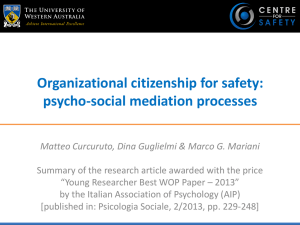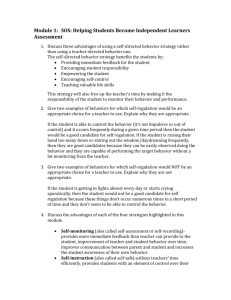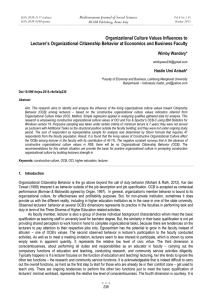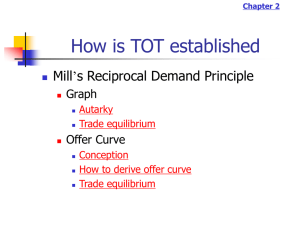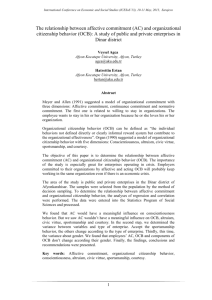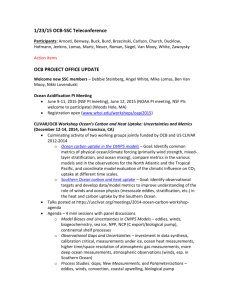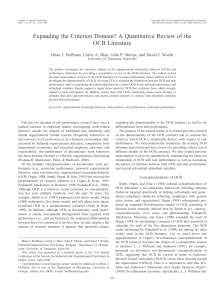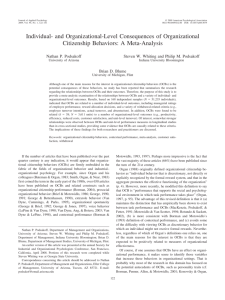Organizational Citizenship Behaviors in a Multi-Cultural
advertisement
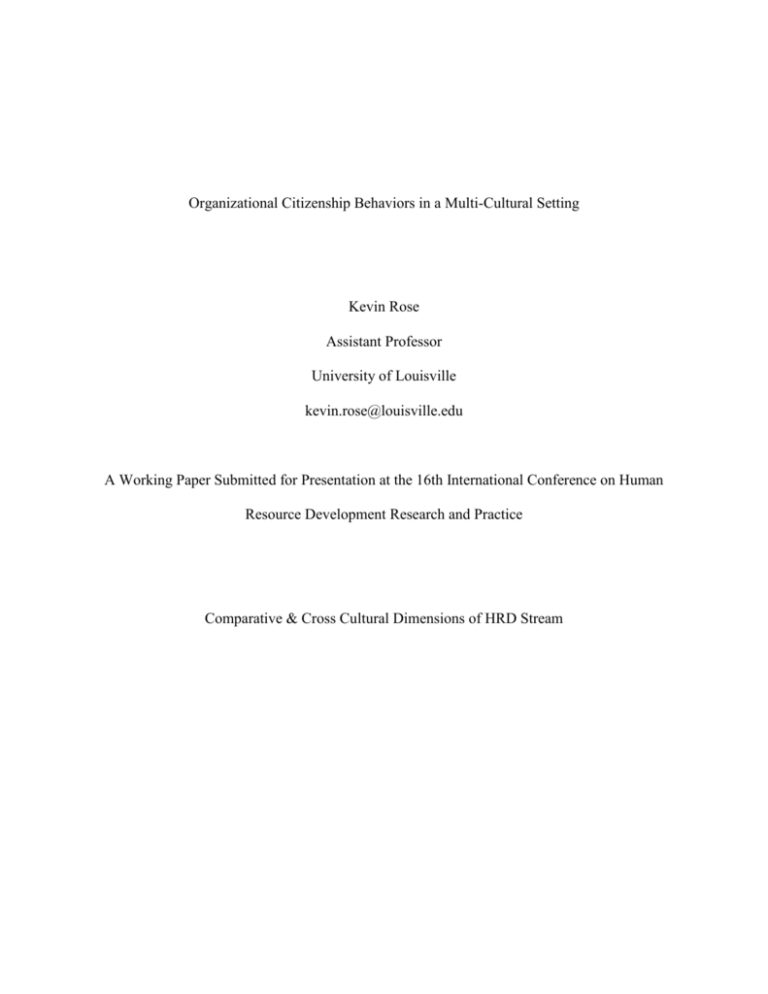
Organizational Citizenship Behaviors in a Multi-Cultural Setting Kevin Rose Assistant Professor University of Louisville kevin.rose@louisville.edu A Working Paper Submitted for Presentation at the 16th International Conference on Human Resource Development Research and Practice Comparative & Cross Cultural Dimensions of HRD Stream Abstract Organizational citizenship behavior (OCB) have been described in the research literature as behaviors that are extra-role, not formally rewarded, and contribute positively to the organization. These kinds of pro-social behaviors are important to team and organizational success because they ensure that social relationships in the organization remain stable and positive. Though understanding these behaviors is important, an oft-ignored, but nevertheless important aspect of these behaviors may be the influence of different cultural backgrounds on the definition and operationalization of OCB. This paper proposes a study of organizational citizenship behaviors (OCB) in an organization employing individuals from various cultural backgrounds. The findings may offer a new aspect for both practitioners and researchers in understanding the phenomenon of OCB. Keywords: organizational citizenship behavior, multiculturalism Organizational Citizenship Behaviors in a Multi-Cultural Setting Organizations are continually striving to become more successful in terms of financial performance, product output, or service delivery (Goldberg & Fleming, 2010). Thus, they turn to their human, physical, and financial capital searching for ways to become more efficient and productive. Scholars and practitioners alike have known that employees (human resources) have a significant impact on the success or failure of organizations, and that by properly motivating them to perform, organizations can see improved metrics of success (Caswell, 2009). Clearly, a major interest of HRM/HRD professionals is to empower employees with proper training, development, and work conditions that lead to organizational performance. However, there is more to employee performance than simply carrying out formal job duties (Organ, 1988). Some activities are undertaken that are not part of employees’ job descriptions, are not rewarded by any formal systems, and yet still contribute positively to the organization (LePine, Erez, & Johnson, 2002). These activities, known as organizational citizenship behaviors (OCBs), have a profound impact on organizations and teams, and investigating them is crucial to understanding social constructs that lead to organizational and team success (Smith, Organ, & Near, 1983). Further, a more nuanced understanding of these behaviors enables both managers and human resource professionals to create the necessary work conditions that foster increased OCB. While scholarly attention to OCB as a line of research is significant, there are still theoretical and conceptual areas for consideration. Most studies involving OCBs have been conducted in the US employment context. Although empirical investigation on OCBs in a non-US context do exist, they are scant (see e.g. Moorman & Blakely, 1995; Farh, Zhong, & Organ, 2004; Cohen, 2006). Furthermore, the existing literature on OCBs does not consider this construct situated in a multi-cultural context involving large numbers of individuals from various cultural and national backgrounds. Thus, the purpose of this study is to understand the differences that may exist between cultural groups in the exhibition of OCB in one organization. Organizational Citizenship Behavior Most scholars believe that OCBs fall into the category of “extra-role” behaviors (Chughtai, 2008), a notion that includes both OCBs and those behaviors employees engage in that are counterproductive and negatively impact the organization, such as retaliation, revenge, and aggression (Miles, Borman, Spector, & Fox, 2002). Although some may argue that counterproductive behaviors exist on a continuum (with OCBs at the opposite end), empirical evidence indicates that OCBs are a separate and distinct construct from negative workplace behaviors (Kelloway, Loughlin, Barling, & Nault, 2002). These two concepts are related, but correlates and predictors differ. For example, Miles, Borman, Spector, and Fox (2002) found that positive emotions in the workplace tend to produce more OCBs while negative emotions are associated with counterproductive behavior. Further research has strengthened the claim that these two sets of behaviors are separate constructs with differing predictors, and even indicate that these behaviors can be simultaneously exhibited by the same individual (Sackett, Berry, Wiemann, & Laczo, 2006). Defining OCB has been the subject of much scholarly research. It has been proposed that OCB is a multidimensional construct, but the construction of those dimensions varies. Many suggest that OCB can be thought of as consisting of five dimensions: altruism, conscientiousness, sportsmanship, courtesy, and civic virtue (LePine, Erez, & Johnson, 2002). However, others propose that there are perhaps seven dimensions to OCB: helping behavior, organizational loyalty, individual initiative, organizational compliance, self-development, civic virtue, and sportsmanship (Podsakoff, et al., 2000). Note the overlap that exists between two previous definitions. Others propose that OCB has but two dimensions: behaviors targeted at individuals and behaviors targeted at the organization (Williams & Anderson, 1991). Differing streams of research have supported each idea of the multidimensionality of OCB and perhaps these dimensions are convergent in some ways. Another issue faced by those interested in understanding OCB is the extra-role nature of these behaviors. While Organ’s (1988) original definition of these behaviors explicitly labeled them as “discretionary” (p. 4), some have argued that fully operationalizing these behaviors as outside of what is required of an employee is problematic (Vey & Campbell, 2004; VigodaGadot, 2007). While some job definitions may not include specific reference to OCB, it is understood that at least some of these behaviors (e.g. helping behavior) are part of a person’s role in the organization. Other circumstances or managers may pressure employees into these kinds of behaviors (both explicitly and implicitly), introducing the notion of a compulsory citizenship behavior (Vigoda-Gadot, 2007). This varying interpretation of OCB points to the hypothesis that the understanding, meaning, and operationalization of OCB may not be universally held across contexts and environments. Moreover, different cultural backgrounds may indeed influence how OCB are enacted even within one organization. Understanding of Work Whether or not OCB are in-role or extra-role may also depend upon the cultural background and influences of an individual. One of the most well-known theories of how work may be different for different cultures is Hofstede’s (1981) theory of cultural dimensions. His work describes how prevailing cultural values may differ in different national cultures, and though his work has been criticized (cf. Blodgett, Bakir, & Rose, 2008), the value of understanding how the meaning of work is constructed is nevertheless important for those who work across national boundaries or in multicultural settings (Smith, 2008). Furthermore, Ciulla (2001) describes the importance of cultural context and how cultural values can influence how an individual constructs the meaning of work and his or her perceptions of what it means to work (the behaviors that are included and excluded). These ideas lend credence to the idea that OCB may be constructed differently in different cultural contexts. These different meanings may be exacerbated in a multinational organization or in a multi-cultural environment where individuals from various cultural backgrounds work together to achieve common goals. Method To understand if differences in OCB exist between different cultural groups within one organization, this study will use a complimentary, sequential mixed-methods design (Brewerton & Millward, 2009). First, a scale measuring OCB and gathering demographic information (including national origin) will be deployed to the target organization. Second, semi-structured interviews with individuals from differing cultural groups in the same organization will be conducted to understand their interpretation, definition, and operationalization of OCB. The specific organization chosen for this study is a branch of a US governmental organization located in a metropolitan European city. This organization employs US citizens (both military and non-military) as well as individuals from the local community (including citizens and non-citizens of the host country). This site provides an interesting opportunity to investigate the enactment of OCB from differing cultural perspectives because of the various nationalities that are employed. ANOVA will be used to compare differences in levels of OCB between cultural groups in this organization. However, qualitative data gained through the interview process may shed light on why and how OCB could differ between groups. Implications for HRD Theory and Practice Understanding OCB from the lens of multiculturalism may help both practitioners and researchers improve the meaning of work for individuals. When differences in cultural values exist, conflict frustration may arise because of differing constructions of the meaning of work. Because of the positive impact of OCB on individuals, teams, and organizations (Chahal & Mehta, 2010), managers and supervisors have an interest in providing work environments conducive to these behaviors. However, a more nuanced understanding of how OCB are understood from the employee perspective and if, indeed, these behaviors may differ between different cultural groups is necessary. Similarly, the theoretical understanding of OCB enactment within organizations may benefit from a more thorough view of these behaviors. Because of the research emphasis on US samples and organizations, a skewed view of OCB (at least from a multicultural perspective) may have arisen. This study may assist with further clarifying and extending the research in this important area and providing a new lens through which to view OCB. References Blodgett, J. G., Bakir, A., & Rose, G. M. (2008). A test of the validity of Hofstede’s cultural framework. Journal of Consumer Marketing, 25(6), 339-349. doi: 10.1108/07363760810902477 Brewerton, P., & Millward, L. (2001). Organizational research methods. Thousand Oaks, CA: Sage Publications. Caswell, B. (2009). Stimulating 'Lazy' Employees. Canadian HR Reporter, 22(2), 21. Chahal, H., & Mehta, S. (2010). Antecedents and consequences of organizational citizenship behaviour (OCB): A conceptual framework in reference to health care sector. Journal of Services Research, 10(2), 25-44. Chughtai, A. A. (2008). Impact of job involvement on in-role job performance and organizational citizenship behaviour. Journal of Behavioral and Applied Management, 9(2), 169-183. Ciulla, J. B. (2001). The working life: The promise and betrayal of modern work. New York, NY: Crown Business. Cohen, A. (2006). The relationship between multiple commitments and organizational citizenship behavior in Arab and Jewish culture. Journal of Vocational Behavior, 69(1), 105-118. Farh, J. L., Zhong, C. B., & Organ, D. W. (2004). Organizational citizenship behavior in the People's Republic of China. Organization Science, 15(2), 241-253. Goldberg, A. J., & Fleming, W. P. (2010). Cost-containment and cost-management strategies. Journal of Healthcare Management, 55(5), 308-311. Hofstede, G. (1981). Culture and organizations. International Studies of Management and Organizations, 10(4), 15-41. Kelloway, E. K., Loughlin, C., Barling, J., & Nault, A. (2002). Self-reported counterproductive behaviors and organizational citizenship behaviors: Separate but related constructs. International Journal of Selection & Assessment, 10(1/2), 143-152. LePine, J. A., Erez, A., & Johnson, D. E. (2002). The nature and dimensionality of organizational citizenship behavior: A critical review and meta-analysis. Journal of Applied Psychology, 87(1), 52-65. Miles, D. E., Borman, W. E., Spector, P. E., & Fox, S. (2002). Building an integrative model of extra role work behaviors: A comparison of counterproductive work behavior with organizational citizenship behavior. International Journal of Selection & Assessment, 10(1/2), 51-58. Moorman, R. H., & Blakely, G. L. (1995). Individualism‐collectivism as an individual difference predictor of organizational citizenship behavior. Journal of organizational behavior, 16(2), 127-142. Organ, D. W. (1988). Organizational Citizenship Behavior: The Good Soldier Syndrome. Lexington, Massachusetts: Lexington Books. Podsakoff, P. M., MacKenzie, S. B., Paine, J. B., & Bachrach, D. G. (2000). Organizational citizenship behaviors: A critical review of the theoretical and empirical literature and suggestions for future research. Journal of Management, 26(3), 513-563. Sackett, P. R., Berry, C. M., Wiemann, S. A., & Laczo, R. M. (2006). Citizenship and counterproductive behavior: Clarifying relations between the two domains. Human Performance, 19(4), 441-464. Smith, P. B. (2008). Indigenous aspects of management. In P. Smith, M. Peterson, & D. Thomas (Eds.), The handbook of cross-cultural management research (pp. 319-332). Thousand Oaks, CA: Sage Publications Smith, C. A., Organ, D. W., & Near, J. P. (1983). Organizational citizenship behavior: Its nature and antecedents. Journal of Applied Psychology, 68(4), 653-663. Vey, M. A., & Campbell, J. P. (2004). In-role or extra-role organizational citizenship behavior: Which are we measuring? Human Performance, 17(1), 119-135. Vigoda-Gadot, E. (2007). Redrawing the boundaries of OCB? An empirical examination of compulsory extra-role behavior in the workplace. Journal of Business & Psychology, 21(3), 377-405. Williams, L. J., & Anderson, S. E. (1991). Job satisfaction and organizational commitment as predictors of organizational citizenship and in-role behaviors. Journal of Management, 17(3), 601-618.
